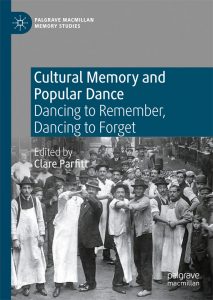Kathy Davis’ Review of Queer Tango Article by Batchelor & Mulholland
 “Queer Tango—Bent History? The Late-Modern Uses and Abuses of Historical: Imagery Showing Men Dancing Tango with Each Other” by Ray Batchelor and Jon Mulholland
“Queer Tango—Bent History? The Late-Modern Uses and Abuses of Historical: Imagery Showing Men Dancing Tango with Each Other” by Ray Batchelor and Jon Mulholland
Included in the new book:
Cultural Memory and Popular Dance: Dancing to Remember, Dancing to Forget
Edited by Clare Parfitt
Published by Palgrave Macmillian, 2022
ISSN 2634-6257
ISSN 2634-6265 (electronic)
Review by Kathy Davis
What a treat to see that wonderful iconic photo of men in butchers’ aprons and Fedoras dancing tango together in turn-of-century Buenos Aires on the cover of Clare Parfitt’s Cultural Memory and Popular Dance! The book is not just about tango; it is an interesting collection of chapters about the role of dancing in how people remember important events. Of course, I immediately turned to the chapter by Ray Batchelor and Jon Mulholland, “Queer Tango—Bent History? The Late Modern Uses and Abuses of Historical Imagery Showing Men Dancing Tango with Each Other.” I figured they were going to set me straight about how I should be thinking about this photograph as well as Queer Tango in its present form.
Every tango dancer worth his/her/their salt knows about men dancing with each other in those early days. But were they just ‘practicing’ because there weren’t enough women available or were they enjoying the pleasures of dancing with each other? Were they all gay (unlikely), embroiled in the sub-proletarian culture of the brothel where degenerate behaviour could be expected (hardly), or only just ‘practicing’ so they could dance with women (you MUST be kidding)? Ray Batchelor and Jon Mulholland poke holes in attempts to ‘remember’ this history in ways that reassure heterosexual audiences by erasing (for them) dangerous and unsettling content. But they are also sceptical of contemporary queer politics which appropriates this history for its own ends. Instead they dig into the history itself by excavating images from postcards, sheet music, and periodicals from the first half of the 20th century. These images show men dancing together, in the pampas, on the streets, in open air markets, and even in the river, proof that however we remember the past, men were definitely there dancing together.
So what does this mean for those of us living in an age where Queer Tango exists as a popular dance, a vibrant culture, and a form of social activism? The authors suggest that we take a queer perspective on history and not let ourselves be taken in by attempts to water down, negate or smooth over the complexities of the past. They ask us to look critically at how images of men (and these images are almost always of men) dancing together in the past are being used in the present, however well-meaning or ‘gentle’ the intentions of those using them may be. I agree whole-heartedly that using historical images to advertise present activities, even ones we like and support, short-changes the queer tango project. They show why it is important to take queer history seriously and this means looking at the heteronormative spaces in which tango, past and present, emerges, often in the cracks and contradictions, the unconventional practices, the subversions. Queer is much more than a sexy picture; it is the cultural landscape that needs to be explored and remembered in all its complexity. We can be grateful to Ray Batchelor and Jon Mulholland for their important work at doing just that.
Kathy Davis